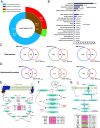CISD3/MiNT is required for complex I function, mitochondrial integrity, and skeletal muscle maintenance
- PMID: 38781208
- PMCID: PMC11145280
- DOI: 10.1073/pnas.2405123121
CISD3/MiNT is required for complex I function, mitochondrial integrity, and skeletal muscle maintenance
Abstract
Mitochondria play a central role in muscle metabolism and function. A unique family of iron-sulfur proteins, termed CDGSH Iron Sulfur Domain-containing (CISD/NEET) proteins, support mitochondrial function in skeletal muscles. The abundance of these proteins declines during aging leading to muscle degeneration. Although the function of the outer mitochondrial CISD/NEET proteins, CISD1/mitoNEET and CISD2/NAF-1, has been defined in skeletal muscle cells, the role of the inner mitochondrial CISD protein, CISD3/MiNT, is currently unknown. Here, we show that CISD3 deficiency in mice results in muscle atrophy that shares proteomic features with Duchenne muscular dystrophy. We further reveal that CISD3 deficiency impairs the function and structure of skeletal muscles, as well as their mitochondria, and that CISD3 interacts with, and donates its [2Fe-2S] clusters to, complex I respiratory chain subunit NADH Ubiquinone Oxidoreductase Core Subunit V2 (NDUFV2). Using coevolutionary and structural computational tools, we model a CISD3-NDUFV2 complex with proximal coevolving residue interactions conducive of [2Fe-2S] cluster transfer reactions, placing the clusters of the two proteins 10 to 16 Å apart. Taken together, our findings reveal that CISD3/MiNT is important for supporting the biogenesis and function of complex I, essential for muscle maintenance and function. Interventions that target CISD3 could therefore impact different muscle degeneration syndromes, aging, and related conditions.
Keywords: Duchenne muscular dystrophy; NDUFV2; NEET/CISD proteins; complex I; mitochondria.
Conflict of interest statement
Competing interests statement:The authors declare no competing interest.
Figures






Update of
-
CISD3 is required for Complex I function, mitochondrial integrity, and skeletal muscle maintenance.bioRxiv [Preprint]. 2023 Jun 4:2023.06.03.543558. doi: 10.1101/2023.06.03.543558. bioRxiv. 2023. Update in: Proc Natl Acad Sci U S A. 2024 May 28;121(22):e2405123121. doi: 10.1073/pnas.2405123121. PMID: 37398338 Free PMC article. Updated. Preprint.
Similar articles
-
CISD3 is required for Complex I function, mitochondrial integrity, and skeletal muscle maintenance.bioRxiv [Preprint]. 2023 Jun 4:2023.06.03.543558. doi: 10.1101/2023.06.03.543558. bioRxiv. 2023. Update in: Proc Natl Acad Sci U S A. 2024 May 28;121(22):e2405123121. doi: 10.1073/pnas.2405123121. PMID: 37398338 Free PMC article. Updated. Preprint.
-
The unique fold and lability of the [2Fe-2S] clusters of NEET proteins mediate their key functions in health and disease.J Biol Inorg Chem. 2018 Jun;23(4):599-612. doi: 10.1007/s00775-018-1538-8. Epub 2018 Feb 12. J Biol Inorg Chem. 2018. PMID: 29435647 Free PMC article. Review.
-
Structure of the human monomeric NEET protein MiNT and its role in regulating iron and reactive oxygen species in cancer cells.Proc Natl Acad Sci U S A. 2018 Jan 9;115(2):272-277. doi: 10.1073/pnas.1715842115. Epub 2017 Dec 19. Proc Natl Acad Sci U S A. 2018. PMID: 29259115 Free PMC article.
-
A VDAC1-mediated NEET protein chain transfers [2Fe-2S] clusters between the mitochondria and the cytosol and impacts mitochondrial dynamics.Proc Natl Acad Sci U S A. 2022 Feb 15;119(7):e2121491119. doi: 10.1073/pnas.2121491119. Proc Natl Acad Sci U S A. 2022. PMID: 35135884 Free PMC article.
-
Structure-function analysis of NEET proteins uncovers their role as key regulators of iron and ROS homeostasis in health and disease.Biochim Biophys Acta. 2015 Jun;1853(6):1294-315. doi: 10.1016/j.bbamcr.2014.10.014. Epub 2014 Oct 23. Biochim Biophys Acta. 2015. PMID: 25448035 Review.
Cited by
-
Oxidative Metabolism as a Cause of Lipid Peroxidation in the Execution of Ferroptosis.Int J Mol Sci. 2024 Jul 9;25(14):7544. doi: 10.3390/ijms25147544. Int J Mol Sci. 2024. PMID: 39062787 Free PMC article. Review.
-
Biochemical and cellular characterization of the CISD3 protein: Molecular bases of cluster release and destabilizing effects of nitric oxide.J Biol Chem. 2024 Mar;300(3):105745. doi: 10.1016/j.jbc.2024.105745. Epub 2024 Feb 12. J Biol Chem. 2024. PMID: 38354784 Free PMC article.
-
A novel (-)-(2S)-7,4'-dihydroxyflavanone compound for treating age-related diabetes mellitus through immunoinformatics-guided activation of CISD3.Biogerontology. 2024 Oct 29;26(1):5. doi: 10.1007/s10522-024-10147-1. Biogerontology. 2024. PMID: 39470889
-
Pulling back the mitochondria's iron curtain.NPJ Metab Health Dis. 2025;3(1):6. doi: 10.1038/s44324-024-00045-y. Epub 2025 Mar 4. NPJ Metab Health Dis. 2025. PMID: 40052109 Free PMC article. Review.
References
-
- Nechushtai R., et al. , The balancing act of NEET proteins: Iron, ROS, calcium and metabolism. Biochim. Biophys. Acta (BBA) Mol. Cell Res. 1867, 118805 (2020). - PubMed
-
- Tamir S., et al. , Structure–function analysis of NEET proteins uncovers their role as key regulators of iron and ROS homeostasis in health and disease. Biochim. Biophys. Acta (BBA) Mol. Cell Res. 1853, 1294–1315 (2015). - PubMed
MeSH terms
Substances
Grants and funding
LinkOut - more resources
Full Text Sources

